Task Writing[上学期]
图片预览
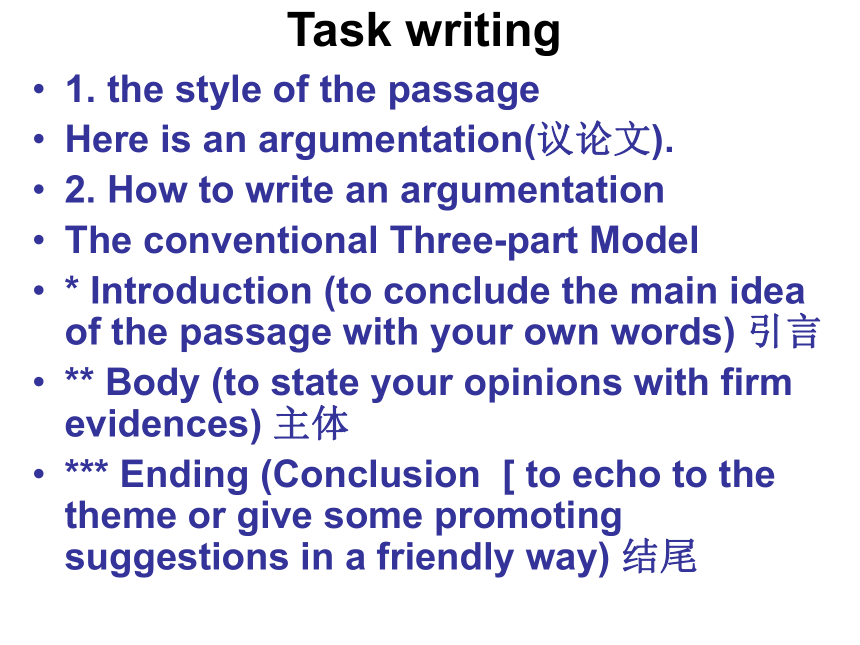
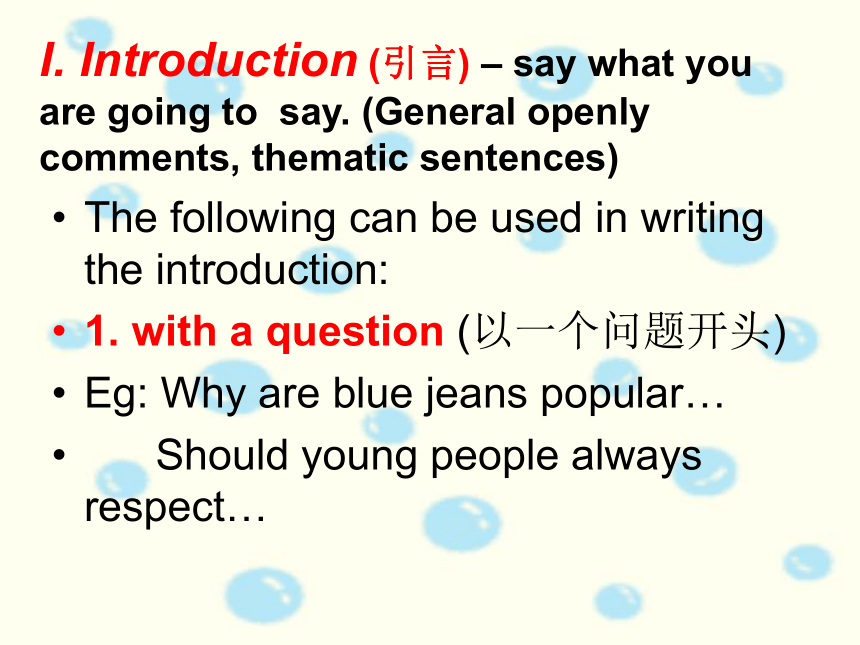
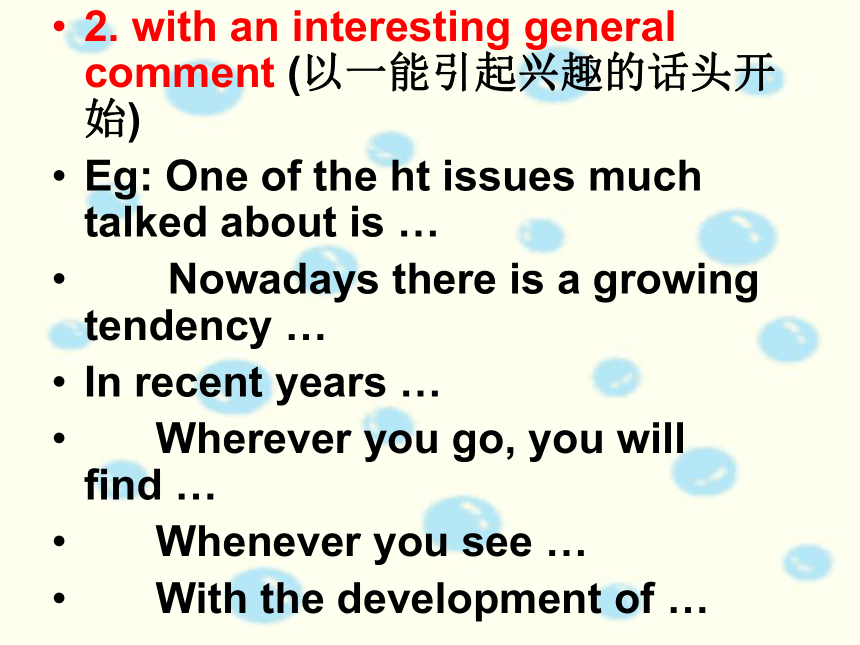

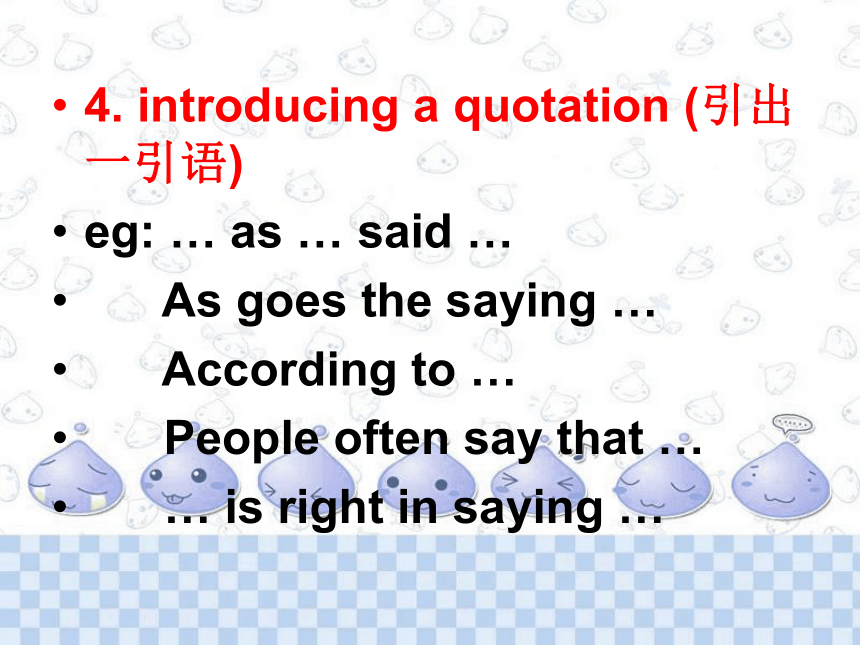
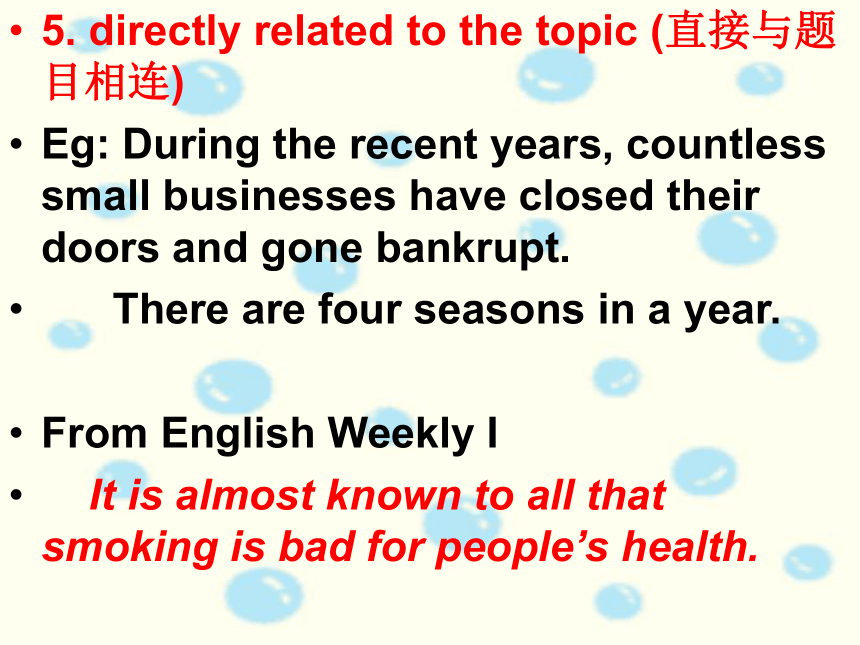
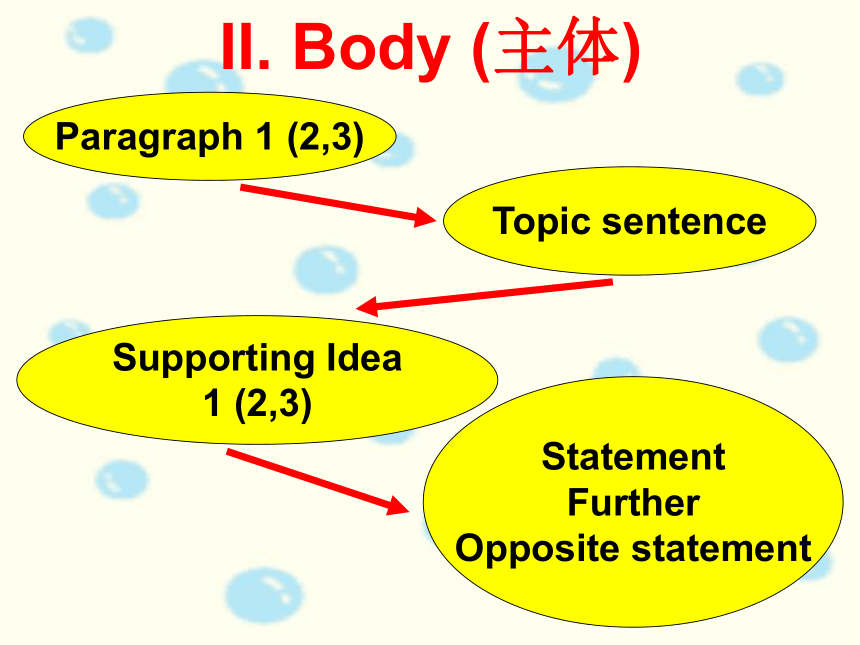
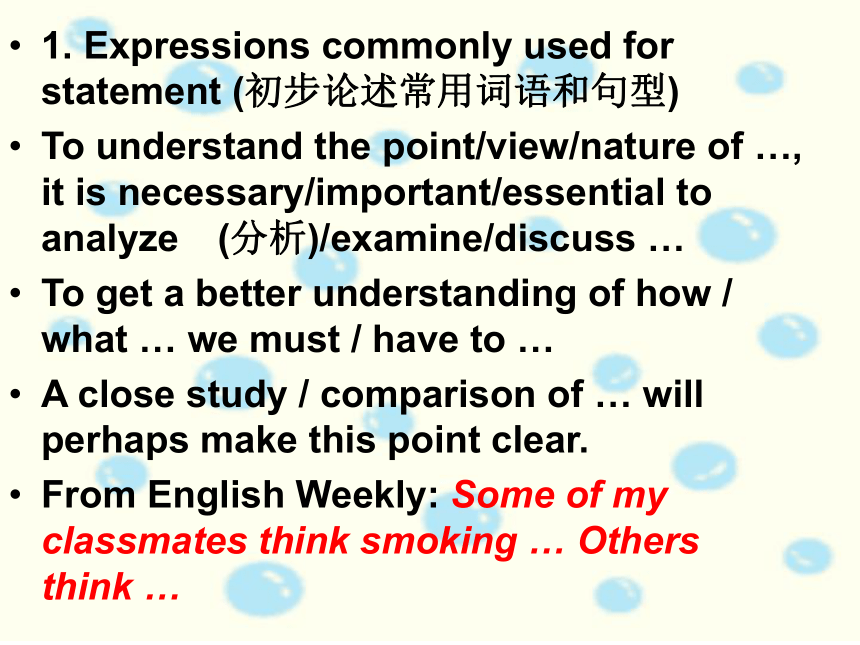
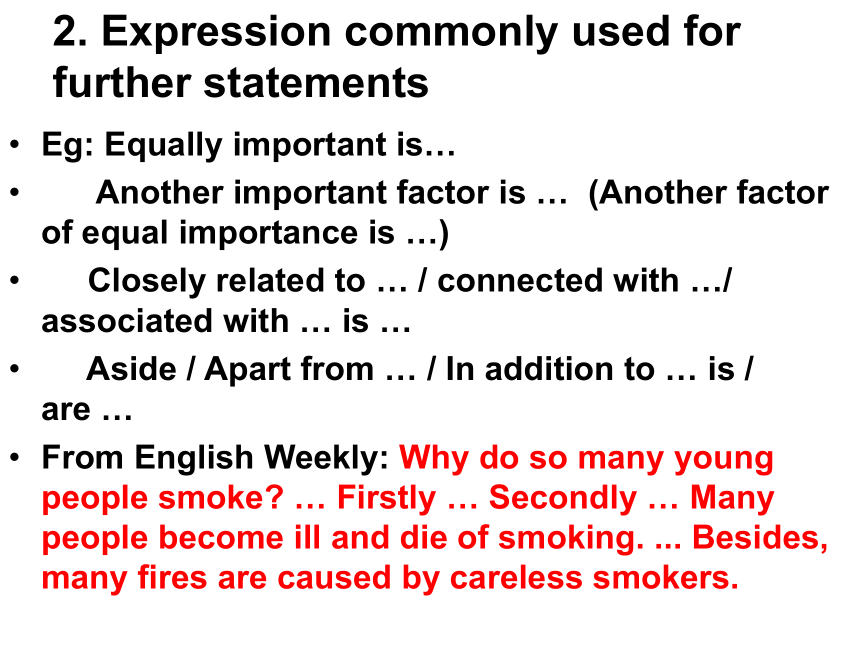
文档简介
课件22张PPT。Task writing 1. the style of the passage
Here is an argumentation(议论文).
2. How to write an argumentation
The conventional Three-part Model
* Introduction (to conclude the main idea of the passage with your own words) 引言
** Body (to state your opinions with firm evidences) 主体
*** Ending (Conclusion [ to echo to the theme or give some promoting suggestions in a friendly way) 结尾I. Introduction (引言) – say what you are going to say. (General openly comments, thematic sentences)The following can be used in writing the introduction:
1. with a question (以一个问题开头)
Eg: Why are blue jeans popular…
Should young people always respect…2. with an interesting general comment (以一能引起兴趣的话头开始)
Eg: One of the ht issues much talked about is …
Nowadays there is a growing tendency …
In recent years …
Wherever you go, you will find …
Whenever you see …
With the development of …3. with a point of view (以一论点开头)
Eg: There is no doubt that…
There is no delaying that …
Nothing is more important / dangerous than… 4. introducing a quotation (引出一引语)
eg: … as … said …
As goes the saying …
According to …
People often say that …
… is right in saying …
5. directly related to the topic (直接与题目相连)
Eg: During the recent years, countless small businesses have closed their doors and gone bankrupt.
There are four seasons in a year.
From English Weekly I
It is almost known to all that smoking is bad for people’s health. II. Body (主体)Paragraph 1 (2,3)Topic sentenceSupporting Idea
1 (2,3)Statement
Further
Opposite statement1. Expressions commonly used for statement (初步论述常用词语和句型)
To understand the point/view/nature of …, it is necessary/important/essential to analyze (分析)/examine/discuss …
To get a better understanding of how / what … we must / have to …
A close study / comparison of … will perhaps make this point clear.
From English Weekly: Some of my classmates think smoking … Others think …2. Expression commonly used for further statementsEg: Equally important is…
Another important factor is … (Another factor of equal importance is …)
Closely related to … / connected with …/ associated with … is …
Aside / Apart from … / In addition to … is / are …
From English Weekly: Why do so many young people smoke? … Firstly … Secondly … Many people become ill and die of smoking. ... Besides, many fires are caused by careless smokers. 3. Expression commonly used for opposite statement (反面论述常用词语和句型)Despite… / Inspite of … / For all … the difficulty / problem / risk / our efforts …
Instead of … / rather than …
On the other hand …; On the contrary…; By contrast … / In contrast to …
But the opposite is usually true / the case … 4. Ways to express supporting ideas (表达论点的常用词语和句型)Listing(列举)
Eg:
…is a typical example
Take … as an example
Let us suppose that …
Just think of / imagine that …
But consider, for example …
Such examples can be found … Cause and effect (因果)There are many reasons for …
The answer to the problem involves many factors …
The reasons are varied, they include …
Thanks to …
Owing to …
… partly because of / due to …
Not because … but because …
… mainly stems from …
That’s why …
Many factors weigh heavily on …
… is not the sole cause for …
Another important reason is …
… is also responsible for … Comparison and contrast (比较和对照)Just as A …, so B …
Like …
A is as much as …
A and B have many things in common.
A …, so / nor B …
A …, whereas / while B …
… no less than …
… not any more than …
The same is true of …Generalization(概括)In general …
Generally speaking …
On the whole, …
In a word, …
… is probably the case …
In most cases …
Commenting and disputing (评论和驳斥)Although …, I doubt / wonder …
People tend to think …
It is true …, but …
You may …, it probably will …
I’d like to argue …
My argue is …
I assume that …
Quite on the contrary …
It is wrong to think …
It would be absurd(可笑的) to …
It may sound reasonable, but I am not sure …Deduction and reasoning (推理)It seems quite likely that …
It is clear / pretty certain that …
There is no delaying that …
No wonder that …
Little is said about …
If this is the case, we may …
Moreover, if …
It is almost impossible … without …
Hardly anyone … without …
No matter how …
The more …, the more …Confirmation(证实)There is strong evidence that …
Recent studies indicate that …
But the most surprising thing is…
Gone are the days …Quotation (引言)Knowledge is power.
Awareness of ignorance is the beginning of wisdom.
Think before you act. III. Ending (结尾)Theme repeated, general closing comments (重复主题,结束语)
Conclusion (表示结论)
In conclusion / To conclude
In short / In summary / To sum up
From what has been discussed above, we may …Suggestion (表示建议)What we need to do …
It is hoped that …
It is high time that …
Awareness of the problem is the first step …Direction (指出方向)True, there may be questions we cannot answer …
The great challenge today is …
We may have a long way to go before …
It remains to be further discussed …IV. Preparing an outline (准备提纲) The principles and techniques that you have already learned for writing the paragraph can be applied to essays. When you organize your thoughts, you should:
Write the topic at the top of the outline.
Write down the topic sentence or phrase of each paragraph.
Provide some relevant information to support the topic sentence.
Write down a clear conclusion.
Here is an argumentation(议论文).
2. How to write an argumentation
The conventional Three-part Model
* Introduction (to conclude the main idea of the passage with your own words) 引言
** Body (to state your opinions with firm evidences) 主体
*** Ending (Conclusion [ to echo to the theme or give some promoting suggestions in a friendly way) 结尾I. Introduction (引言) – say what you are going to say. (General openly comments, thematic sentences)The following can be used in writing the introduction:
1. with a question (以一个问题开头)
Eg: Why are blue jeans popular…
Should young people always respect…2. with an interesting general comment (以一能引起兴趣的话头开始)
Eg: One of the ht issues much talked about is …
Nowadays there is a growing tendency …
In recent years …
Wherever you go, you will find …
Whenever you see …
With the development of …3. with a point of view (以一论点开头)
Eg: There is no doubt that…
There is no delaying that …
Nothing is more important / dangerous than… 4. introducing a quotation (引出一引语)
eg: … as … said …
As goes the saying …
According to …
People often say that …
… is right in saying …
5. directly related to the topic (直接与题目相连)
Eg: During the recent years, countless small businesses have closed their doors and gone bankrupt.
There are four seasons in a year.
From English Weekly I
It is almost known to all that smoking is bad for people’s health. II. Body (主体)Paragraph 1 (2,3)Topic sentenceSupporting Idea
1 (2,3)Statement
Further
Opposite statement1. Expressions commonly used for statement (初步论述常用词语和句型)
To understand the point/view/nature of …, it is necessary/important/essential to analyze (分析)/examine/discuss …
To get a better understanding of how / what … we must / have to …
A close study / comparison of … will perhaps make this point clear.
From English Weekly: Some of my classmates think smoking … Others think …2. Expression commonly used for further statementsEg: Equally important is…
Another important factor is … (Another factor of equal importance is …)
Closely related to … / connected with …/ associated with … is …
Aside / Apart from … / In addition to … is / are …
From English Weekly: Why do so many young people smoke? … Firstly … Secondly … Many people become ill and die of smoking. ... Besides, many fires are caused by careless smokers. 3. Expression commonly used for opposite statement (反面论述常用词语和句型)Despite… / Inspite of … / For all … the difficulty / problem / risk / our efforts …
Instead of … / rather than …
On the other hand …; On the contrary…; By contrast … / In contrast to …
But the opposite is usually true / the case … 4. Ways to express supporting ideas (表达论点的常用词语和句型)Listing(列举)
Eg:
…is a typical example
Take … as an example
Let us suppose that …
Just think of / imagine that …
But consider, for example …
Such examples can be found … Cause and effect (因果)There are many reasons for …
The answer to the problem involves many factors …
The reasons are varied, they include …
Thanks to …
Owing to …
… partly because of / due to …
Not because … but because …
… mainly stems from …
That’s why …
Many factors weigh heavily on …
… is not the sole cause for …
Another important reason is …
… is also responsible for … Comparison and contrast (比较和对照)Just as A …, so B …
Like …
A is as much as …
A and B have many things in common.
A …, so / nor B …
A …, whereas / while B …
… no less than …
… not any more than …
The same is true of …Generalization(概括)In general …
Generally speaking …
On the whole, …
In a word, …
… is probably the case …
In most cases …
Commenting and disputing (评论和驳斥)Although …, I doubt / wonder …
People tend to think …
It is true …, but …
You may …, it probably will …
I’d like to argue …
My argue is …
I assume that …
Quite on the contrary …
It is wrong to think …
It would be absurd(可笑的) to …
It may sound reasonable, but I am not sure …Deduction and reasoning (推理)It seems quite likely that …
It is clear / pretty certain that …
There is no delaying that …
No wonder that …
Little is said about …
If this is the case, we may …
Moreover, if …
It is almost impossible … without …
Hardly anyone … without …
No matter how …
The more …, the more …Confirmation(证实)There is strong evidence that …
Recent studies indicate that …
But the most surprising thing is…
Gone are the days …Quotation (引言)Knowledge is power.
Awareness of ignorance is the beginning of wisdom.
Think before you act. III. Ending (结尾)Theme repeated, general closing comments (重复主题,结束语)
Conclusion (表示结论)
In conclusion / To conclude
In short / In summary / To sum up
From what has been discussed above, we may …Suggestion (表示建议)What we need to do …
It is hoped that …
It is high time that …
Awareness of the problem is the first step …Direction (指出方向)True, there may be questions we cannot answer …
The great challenge today is …
We may have a long way to go before …
It remains to be further discussed …IV. Preparing an outline (准备提纲) The principles and techniques that you have already learned for writing the paragraph can be applied to essays. When you organize your thoughts, you should:
Write the topic at the top of the outline.
Write down the topic sentence or phrase of each paragraph.
Provide some relevant information to support the topic sentence.
Write down a clear conclusion.
